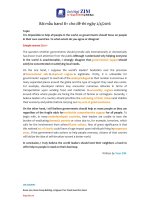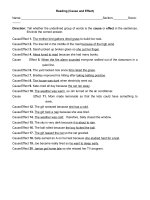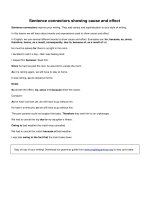Essay mẫu về cause and effect unemployment
Bạn đang xem bản rút gọn của tài liệu. Xem và tải ngay bản đầy đủ của tài liệu tại đây (70.55 KB, 14 trang )
Topic: What are the causes and effects of unemployment
Unemployment occurs when a person is able and willing to work but
currently without work. The prevalence of unemployment is usually measured
using the unemployment rate, which is defined as the percentage of those in the
labour force who are unemployed. The unemployment rate is also used in
economic studies and economic indices such as the United States’ Conference
Board’s Index of Leading Indicators as a measure of the state of
macroeconomics.
The causes of unemployment are disputed. Keynesian economics
emphasizes unemployment resulting from insufficient effective demand for
goods and services in the economy (cyclical unemployment). Others point to
structural problems and inefficiencies inherent in labour markets; structural
unemployment involves mismatches between demand and supply of laborers
with the necessary skill set, sometimes induced by technologies or globalisation.
Classical orneo classical economics tends to reject these explanations, and
focuses more on rigidities imposed on the labor market from the outside, such
as unionization, minimum wage laws, taxes, and other regulations that may
discourage the hiring of workers (classical unemployment). Yet others see
unemployment as largely due to voluntary choices by the unemployed and the
time it takes to find a new job (frictional unemployment). Behavioral economics
highlights phenomena such as sticky wages and efficiency wages which may
lead to unemployment.
There is also disagreement on how exactly to measure unemployment.
Different countries experience different levels of unemployment; traditionally,
the United States tends to experience lower unemployment levels than countries
in the European Union,[2] although there is some variation there, with countries
like the UK and Denmark outperforming Italy and France and it also changes
over time (e.g. the Great Depression) throughout economic cycles.
Types of unemployment
Economists distinguish between various types of unemployment, including
cyclical unemployment, frictional unemployment, structural unemployment and
classical unemployment. Some additional types of unemployment that are
occasionally mentioned are seasonal unemployment, hardcore unemployment,
and hidden unemployment. Real-world unemployment may combine different
types. The magnitude of each of these is difficult to measure, partly because
they overlap.
Though there have been several definitions of voluntary and involuntary
unemployment in the economics literature, a simple distinction is often applied.
Voluntary unemployment is attributed to the individual’s decisions, whereas
involuntary unemployment exists because of the socio-economic environment
(including the market structure, government intervention, and the level of
aggregate demand) in which individuals operate. In these terms, much or most
of frictional unemployment is voluntary, since it reflects individual search
behaviour.
On the other hand, cyclical unemployment, structural unemployment, and
classical unemployment are largely involuntary in nature. However, the
existence of structural unemployment may reflect choices made by the
unemployed in the past, while classical (natural) unemployment may result
from the legislative and economic choices made by labour unions and/or
political parties. So in practice, the distinction between voluntary and
involuntary unemployment is hard to draw. The clearest cases of involuntary
unemployment are those where there are fewer job vacancies than unemployed
workers even when wages are allowed to adjust, so that even if all vacancies
were to be filled, there would be unemployed workers. This is the case of
cyclical
unemployment,
for
which
macroeconomic
forces
lead
to
microeconomic unemployment.
Frictional unemployment
Frictional unemployment is the time period between jobs when a worker
moves from one job to another. Frictional unemployment is an example of a
productive part of the economy, increasing both the worker’s long term welfare
and economic efficiency, and is also a type of voluntary unemployment.
Frictional unemployment is always present in an economy, so the level of
involuntary unemployment is properly the unemployment rate minus the rate of
frictional unemployment, which means that increases or decreases in
unemployment are normally under-represented in the simple statistics.
Classical unemployment
Classical or real-wage unemployment occurs when real wages for a job are
set above the market-clearing level, causing the number of job-seekers to
exceed the number of vacancies.
Libertarian economists like F.A. Hayek argued that unemployment increases
the more the government intervenes into the economy to try to improve the
conditions of those with jobs. For example, minimum wage laws raise the cost
of labourers with few skills to above the market equilibrium, resulting in people
who wish to work at the going rate but cannot as wage enforced is greater than
their value as workers becoming unemployed. They believed that laws
restricting layoffs made businesses less likely to hire in the first place, as hiring
becomes more risky, leaving many young people unemployed and unable to
find work.
Some, such as Murray Rothbard, suggest that even social taboos can prevent
wages from falling to the market clearing level.
Some economists theorize that this type of unemployment can be reduced
by increasing the flexibility of wages (e.g., abolishing minimum wages or
employee protection), to make the labor market more like a financial market
Cyclical or Keynesian unemployment
Cyclical or Keynesian unemployment, also known as deficient-demand
unemployment, occurs when there is not enough aggregate demand in the
economy. It gets its name because it varies with the business cycle, though it
can also be persistent, as during the Great Depression of the 1930s. Cyclical
unemployment is caused by a business cycle recession, and wages not falling to
meet the equilibrium level. Cyclical unemployment rises during economic
downturns and falls when the economy improves. Keynesians argue that this
type of unemployment exists due to inadequate effective aggregate demand.
Demand for most goods and services falls, less production is needed and
consequently fewer workers are needed, wages do not fall to meet the
equilibrium level, and mass unemployment results.
Some consider this type of unemployment one type of frictional
unemployment in which factors causing the friction are partially caused by
some cyclical variables. For example, a surprise decrease in the money supply
may shock participants in society.
With cyclical unemployment, the number of unemployed workers exceeds
the number of job vacancies, so that if even all open jobs were filled, some
workers would remain unemployed. This kind of unemployment coincides with
unused industrial capacity (unemployed capital goods). Keynesian economists
see it as possibly being solved by government deficit spending or by
expansionary monetary policy, which aims to increase non-governmental
spending by lowering interest rates.
In contrast, Austrian economists argue that government spending and
policies are the root cause of economic cycles and cyclical unemployment and
should be reformed or removed.
Classical economics rejects the conception of cyclical unemployment,
seeing the attainment of full employment of resources and potential output as
the normal state of affairs.
Structural unemployment
Structural unemployment occurs when a labor market is unable to provide
jobs for everyone who wants one because there is a mismatch between the skills
of the unemployed workers and the skills needed for the available jobs.[10]
Structural unemployment is hard to separate empirically from frictional
unemployment, except to say that it lasts longer. As with frictional
unemployment, simple demand-side stimulus will not work to easily abolish
this type of unemployment.
Structural unemployment may also be encouraged to rise by persistent
cyclical unemployment: if an economy suffers from long-lasting low aggregate
demand, it means that many of the unemployed become disheartened, while
their skills (including job-searching skills) become “rusty” and obsolete.
Problems with debt may lead to homelessness and a fall into the vicious circle
of poverty. This means that they may not fit the job vacancies that are created
when the economy recovers. Some economists see this scenario as occurring
under British Prime Minister Margaret Thatcher during the 1970s and 1980s.
The implication is that sustained high demand may lower structural
unemployment. This theory of persistence in structural unemployment has been
referred to as an example of path dependence or “hysteresis”.
Much technological unemployment (e.g. due to the replacement of workers
by machines) might be counted as structural unemployment. Alternatively,
technological unemployment might refer to the way in which steady increases
in labor productivity mean that fewer workers are needed to produce the same
level of output every year. The fact that aggregate demand can be raised to deal
with this problem suggests that this problem is instead one of cyclical
unemployment. As indicated by Okun’s Law, the demand side must grow
sufficiently quickly to absorb not only the growing labor force but also the
workers made redundant by increased labor productivity. Otherwise, we see a
jobless recovery such as those seen in the United States in both the early 1990s
and the early 2000s.
Seasonal unemployment may be seen as a kind of structural unemployment,
since it is a type of unemployment that is linked to certain kinds of jobs
(construction
work,
migratory
farm
work).
The
most-cited
official
unemployment measures erase this kind of unemployment from the statistics
using “seasonal adjustment” techniques.
Long-term unemployment
This is normally defined, for instance in European Union statistics, as
unemployment lasting for longer than one year. It is an important indicator of
social exclusion.
Hidden unemployment
Hidden, or covered, unemployment is the unemployment of potential
workers that is not reflected in official unemployment statistics, due to the way
the statistics are collected. In many countries only those who have no work but
are actively looking for work (and/or qualifying for social security benefits) are
counted as unemployed. Those who have given up looking for work (and
sometimes those who are on Government “retraining” programmes) are not
officially counted among the unemployed, even though they are not employed.
The same applies to those who have taken early retirement to avoid being laid
off, but would prefer to be working. The statistic also does not count the
“underemployed” – those with part time or seasonal jobs who would rather have
full time jobs. Because of hidden unemployment, official statistics often
underestimate unemployment rates.
Full employment.
In demand-based theory, it is possible to abolish cyclical unemployment by
increasing the aggregate demand for products and workers. However,
eventually the economy hits an “inflation barrier” imposed by the four other
kinds of unemployment to the extent that they exist.
Some demand theory economists see the inflation barrier as corresponding
to the natural rate of unemployment. The “natural” rate of unemployment is
defined as the rate of unemployment that exists when the labor market is in
equilibrium and there is pressure for neither rising inflation rates nor falling
inflation rates. An alternative technical term for this rate is the NAIRU or the
Non-Accelerating Inflation Rate of Unemployment.
No matter what its name, demand theory holds that this means that if the
unemployment rate gets “too low,” inflation will get worse and worse
(accelerate) in the absence of wage and price controls (incomes policies).
One of the major problems with the NAIRU theory is that no one knows
exactly what the NAIRU is (while it clearly changes over time). The margin of
error can be quite high relative to the actual unemployment rate, making it hard
to use the NAIRU in policy-making.
Another, normative, definition of full employment might be called the ideal
unemployment rate. It would exclude all types of
Causes of frictional unemployment
Frictional unemployment may be a result of the following reasons:
Mobility of labour:
People generally seek another job either because they are fired from the
existing job or because they are they want to get a better job. In the transition
period they are unemployed.
Expansion of the Labour force
Every year more and more individuals join the labor force. During the phase
of their job search they are unemployed.
Many economists have termed frictional unemployment a sign of economic
well being. Frictional unemployment can exist only in a fast growing economy
where the labor force is expanding, mobile, flexible and adaptable. People
generally seek another job either because they are fired from the existing job or
because they are they want to get a better job. In the transition period they are
unemployed.
Expansion of the Labour force
Every year more and more individuals join the labor force. During the phase
of their job search they are unemployed.
Many economists have termed frictional unemployment a sign of economic
well being. Frictional unemployment can exist only in a fast growing economy
where the labor force is expanding, mobile, flexible and adaptable.
Labour mobility
In the presence of perfect information and mobility of labor, people out of
job can easily find in an industry, which is in need of labor. This way, structural
unemployment may be reduced.
Structure of the regional economy
If certain industries are closing down then it may so happen that industries
may get concentrated in a certain part of the nation. This may make
employment difficult and increase the resulting structural unemployment.
High Gross Domestic Product, it is seen, is not indicative of a low structural
unemployment :
The main reason for the high level of unemployment is technological
progress. Don’t get me wrong; progress is good and it makes life easier. But if
every year we produce the same amount of goods with fewer people — in a few
years far less working hours are needed to produce all the goods that are
required. The historical trend has been to use less and less working hours per
week. If we do not continue this trend, the supply of working hours is greater
than the demand. An oversupply of working hours means they are worth less,
wages and salaries get reduced. Also many persons are out of work; their
working hours are no longer needed. Those that are out of work have no income
and therefore the demand for goods goes down. With fewer sales, less gets
produced, more persons are laid off. This is a vicious circle that accelerates
unemployment and produces crime; because some will turn to crime to obtain
income .
Causes Of Unemployment In Pakistan:
Economy of an individual is at the utmost priority of every democratic as
well as welfare state. Since the dawn of human history, individual needs have
been prioritized by every human being. These individual needs can be met by
proper sources of employment. After the transformation of the world from a
feudal to an industrial society, the needs of an individual have risen sharply,
giving due importance to finance.In Pakistan, due to gigantic rise in population,
individual finances have been disturbed a lot. This is because of rising
unemployment. The major cause of unemployment in Pakistan are following.
The first cause of unemployment or joblessness in Pakistan is worsening
law and order situation. Owing to this negative social phenomenon, foreign
direct investment is sliding down to the bottom. According to the economic
survey of Pakistan, in the current decade FDI was minimum last year.Also
investors are loosing confidence in the political and economic system of the
country therefore they are reluctant to invest in any new business venture.
Resultantly, new jobs are not generating while the job seekers are rising
continuously in the country.
Secondly, Agriculture is account for the maximum job provision in the
country. Agriculture sector is facing severe challenges of water shortage,
climatic changes and technological backwardness in recent years. These factors
have hit the per acre yield negatively which caused loosing of jobs of several
people. In 2009-10, agriculture showed a growth of only 2% against the target
of 3.8% while nearly 62% of Pakistan population is living in rural areas, and is
directly or indirectly linked with agriculture for their livelihood.
Thirdly, Industry is also a heaven for educated as well as semi-educated
labour force in the country. Pakistan industry is short listing its labour because
of gradual decrease in demand as well as acute energy shortage. Energy
shortfall crosses 5500 MW at time causing severe damage to production
capacity.
Fourthly, World economic depression coupled with American war against
Terror has also put negative impacts on our economy. It has not only doubled
our expenditures on military front but also defaced Pakistan’s image in
international arena. These factors have put international investment in Pakistan
at risk. Therefore, Pakistan is not attracting new investment causing
unemployment in the country.
Fifthly, United States of America spent 368 billion in 2007 on research and
development whereas Pakistan’s attention towards this sector is the least. By
spending on education and research, we can create more specialized fields thus
generating more jobs. In the 2010 budget, Pakistan has earmarked only 2% of
its GDP on education which is the lowest in whole of the region.
Sixthly, Population increase is also a cause of unemployment in Pakistan.
Till 2010, Pakistan’s population is 173.54 million wheras most of the
population is unable to survive in the financial race because of illiteracy. In
Spite of these factors poor governance, deep rooted corruption, faulty
educational system, lack of quality educational institutions and feudalism are
also aggravating the situation further.
Finally, we can hold the government responsible for the its poor
performance in financial sector. Poor governance have marred the performance
of our economic sector by every side and government has taken only cosmetic
measures to redress the problem. Dr. Ishrat Hussain suggestions to improve the
governance have been put on the backburner.
Economy of an individual is at the utmost priority of every democratic as
well as welfare state. Since the dawn of human history, individual needs have
been prioritized by every human being. These individual needs can be met by
proper sources of employment. After the transformation of the world from a
feudal to an industrial society, the needs of an individual have risen sharply,
giving due importance to finance.In Pakistan, due to gigantic rise in population,
individual finances have been disturbed a lot. This is because of rising
unemployment. The major cause of unemployment in Pakistan are following.
The first cause of unemployment or joblessness in Pakistan is worsening
law and order situation. Owing to this negative social phenomenon, foreign
direct investment is sliding down to the bottom. According to the economic
survey of Pakistan, in the current decade FDI was minimum last year.Also
investors are loosing confidence in the political and economic system of the
country therefore they are reluctant to invest in any new business venture.
Resultantly, new jobs are not generating while the job seekers are rising
continuously in the country.
Secondly, Agriculture is account for the maximum job provision in the
country. Agriculture sector is facing severe challenges of water shortage,
climatic changes and technological backwardness in recent years. These factors
have hit the per acre yield negatively which caused loosing of jobs of several
people. In 2009-10, agriculture showed a growth of only 2% against the target
of 3.8% while nearly 62% of Pakistan population is living in rural areas, and is
directly or indirectly linked with agriculture for their livelihood.
Thirdly, Industry is also a heaven for educated as well as semi-educated
labour force in the country. Pakistan industry is short listing its labour because
of gradual decrease in demand as well as acute energy shortage. Energy
shortfall crosses 5500 MW at time causing severe damage to production
capacity.
Fourthly, World economic depression coupled with American war against
Terror has also put negative impacts on our economy. It has not only doubled
our expenditures on military front but also defaced Pakistan’s image in
international arena. These factors have put international investment in Pakistan
at risk. Therefore, Pakistan is not attracting new investment causing
unemployment in the country.
THÔNG TIN HỎI ĐÁP:
--------------------------
Trong quá trình làm bài Essay, bạn muốn tìm kiếm thêm nhiều tài liệu bài
mẫu, cách làm bài Essay cập nhật mới của Trung tâm Best4Team
Liên hệ dịch vụ thuê viết essay tiếng anh
Hoặc qua SĐT Zalo: 091.552.1220 hoặc email:
để hỗ trợ ngay nhé!









